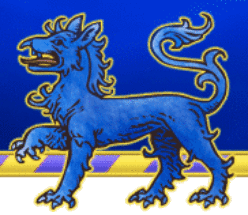LoARs are published on the Laurel Archives page each month.
The Society College of Arms runs on monthly cycles and letters. Each month, the College processes name and armory submissions from all of the Kingdoms. Final decisions on submissions are made at the monthly meetings of the Pelican Queen of Arms (names) and the Wreath King of Arms (armory). Pelican and Wreath then write up their decisions in a Letter of Acceptances and Return (LoAR). After review and proofreading, LoARs generally are released two months after the meeting where the decisions are made.
- An “acceptance” indicates that the item(s) listed are now registered with the Society.
- A “return” indicates that the item is returned to the submitter for additional work.
- A “pend” indicates that the item is being held for a month while additional research or work is done.
East Acceptances
Ada Wright. Name and device. Per pale gules and argent, three square weaver’s tablets counterchanged.
Nice English name from the mid-15th century onwards!
Angela Vittoria di Enrico Spinelli. Name.
Submitted as Angela Vittoria D’Enrico Spinelli, the name was not correctly formed. In medieval Italian, the patronymic marker di did not elide to d’ before a vowel. We have corrected the name to Angela Vittoria di Enrico Spinelli for registration.
Arnora Ketilsdottir. Badge. Per chevron argent and sable, a chevron rompu azure and in base a compass star Or.
There is a step from period practice for the use of a compass star.
Deirdre Grenewode. Name and device. Azure, on a lozenge argent an acorn azure.
This name combines a standardized Gaelic given name with an English byname, an acceptable lingual mix under Appendix C.
Eva von Kölln. Device. Vert, surmounting a cross between in chief two oak leaves and in base two otters statant erect addorsed argent, a heart Or.
Freydis in illa. Name.
This name uses the feminine form of the attested Old Norse descriptive byname inn illi. As a general rule, descriptive bynames based on nouns in Old Norse do not change spelling to match the gender of the given name; descriptive bynames based on adjectives, however, generally do change for gender. Because inn illi is an adjectival byname, the feminine form, in illa, must be used with the female given name Freydis.
Gisla Skogadottir. Name.
Julian zum weißen Raben. Name and device. Per fess sable and Or, on a sun counterchanged a raven displayed sable and a raven displayed argent.
Submitted as Julian Weissraben, the pattern for the byname could not be documented. The Letter of Intent argued that Weissraben was a plausible constructed German byname. However, we were unable to find any examples of two element German bynames in the pattern Color + Animal. The only examples in the Letter of Intent were of Color + Inanimate Object, such as Weißärmel (white sleeve), which does not support the requested name.
On the other hand, the combination of a color and an animal is found in German inn-sign bynames, such as zum Roden Lewen (at/from the Red Lion). With the submitter’s permission, we have changed this name to Julian zum weißen Raben, using an attested German pattern and meaning. “at/from the White Raven.”
There is a step from period practice for the use of birds in the displayed posture other than eagles.
Kunigunde Wedeman. Name.
Morwenna Penrose. Name and device. Azure scaly argent, a ray of the sun issuant from dexter chief Or.
Natal’ia Bolotnikova. Name.
Silas Oein. Name and device. Argent, an elephant and a base sable.
Submitted as Silas mac Eoin, the Scots byname Oein was suggested by Adelaide Pympernell in commentary. The submitter prefers this byname and requested a change. We have done so.
Silas is the submitter’s legal given name. However, the submitter does not need to rely on the Legal Name Allowance because Silas is also a late period English given name.
Silas Oein. Badge. (Fieldless) A bat purpure.
Symon of Barnsdale. Badge. (Fieldless) Three lozenges conjoined in pall azure.
East Returns
None.
